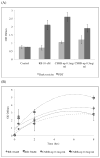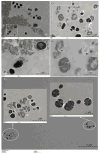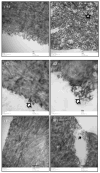Photoactivated rose bengal functionalized chitosan nanoparticles produce antibacterial/biofilm activity and stabilize dentin-collagen
- PMID: 24200522
- PMCID: PMC3966929
- DOI: 10.1016/j.nano.2013.10.010
Photoactivated rose bengal functionalized chitosan nanoparticles produce antibacterial/biofilm activity and stabilize dentin-collagen
Abstract
Treatment of infected teeth presents two major challenges: persistence of the bacterial-biofilm within root canals after treatment and compromised structural integrity of the dentin hard-tissue. In this study bioactive polymeric chitosan nanoparticles functionalized with rose-bengal, CSRBnp were developed to produce antibiofilm effects as well as stabilize structural-integrity by photocrosslinking dentin-collagen. CSRBnp were less toxic to fibroblasts and had significant antibacterial activity even in the presence of bovine serum albumin. CSRBnp exerted antibacterial mechanism by adhering to bacterial cell surface, permeabilizing the membrane and lysing the cells subsequent to photodynamic treatment. Photoactivated CSRBnp resulted in reduced viability of Enterococcus faecalis biofilms and disruption of biofilm structure. Incorporation of CSRBnp and photocrosslinking significantly improved resistance to degradation and mechanical strength of dentin-collagen (P<0.05). The functionalized chitosan nanoparticles provided a single-step treatment of infected root dentin by combining the properties of chitosan and that of photosensitizer to eliminate bacterial-biofilms and stabilize dentin-matrix.
From the clinical editor: In this study, bioactive polymeric chitosan nanoparticles functionalized with rose-bengal (a photosensitizer), CSRBnp were developed to produce antibiofilm effects as well as stabilize structural-integrity of dental root dentin by photocrosslinking dentin-collagen, leading to efficient elimination of bacterial-biofilms and stabilization of dentin-matrix.
Keywords: Biofilms; Chitosan; Collagen; Dentin; Functionalized nanoparticles; Photodynamic therapy.
Copyright © 2014 Elsevier Inc. All rights reserved.
Figures







Similar articles
-
Antibacterial efficacy of photosensitizer functionalized biopolymeric nanoparticles in the presence of tissue inhibitors in root canal.J Endod. 2014 Apr;40(4):566-70. doi: 10.1016/j.joen.2013.09.013. Epub 2013 Oct 23. J Endod. 2014. PMID: 24666913
-
Characterization of a conjugate between Rose Bengal and chitosan for targeted antibiofilm and tissue stabilization effects as a potential treatment of infected dentin.Antimicrob Agents Chemother. 2012 Sep;56(9):4876-84. doi: 10.1128/AAC.00810-12. Epub 2012 Jul 9. Antimicrob Agents Chemother. 2012. PMID: 22777042 Free PMC article.
-
Antibiofilm efficacy of photosensitizer-functionalized bioactive nanoparticles on multispecies biofilm.J Endod. 2014 Oct;40(10):1604-10. doi: 10.1016/j.joen.2014.03.009. Epub 2014 Apr 29. J Endod. 2014. PMID: 25260731
-
Nanosized Building Blocks for Customizing Novel Antibiofilm Approaches.J Dent Res. 2017 Feb;96(2):128-136. doi: 10.1177/0022034516679397. Epub 2016 Nov 19. J Dent Res. 2017. PMID: 27856967 Free PMC article. Review.
-
The action of microbial collagenases in dentinal matrix degradation in root caries and potential strategies for its management: a comprehensive state-of-the-art review.J Appl Oral Sci. 2024 May 20;32:e20240013. doi: 10.1590/1678-7757-2024-0013. eCollection 2024. J Appl Oral Sci. 2024. PMID: 38775556 Free PMC article. Review.
Cited by
-
Deciphering 3D periodontal fibroblast-macrophage crosstalk in bioactive nanoparticle-guided immunomodulation for treating traumatic dental avulsion.Bioact Mater. 2024 Jul 31;41:400-412. doi: 10.1016/j.bioactmat.2024.07.017. eCollection 2024 Nov. Bioact Mater. 2024. PMID: 39184829 Free PMC article.
-
Nanocarrier-based Drug Delivery Systems to Enhance Antimicrobial Photodynamic Therapy in Dental Applications: A Review.AAPS PharmSciTech. 2025 Jun 3;26(5):160. doi: 10.1208/s12249-025-03155-y. AAPS PharmSciTech. 2025. PMID: 40461912 Review.
-
The applicability of furfuryl-gelatin as a novel bioink for tissue engineering applications.J Biomed Mater Res B Appl Biomater. 2019 Feb;107(2):314-323. doi: 10.1002/jbm.b.34123. Epub 2018 Apr 15. J Biomed Mater Res B Appl Biomater. 2019. PMID: 29656592 Free PMC article.
-
Rose Bengal Crosslinking to Stabilize Collagen Sheets and Generate Modulated Collagen Laminates.Int J Mol Sci. 2020 Oct 8;21(19):7408. doi: 10.3390/ijms21197408. Int J Mol Sci. 2020. PMID: 33049938 Free PMC article.
-
Novel Utilization of Therapeutic Coatings Based on Infiltrated Encapsulated Rose Bengal Microspheres in Porous Titanium for Implant Applications.Pharmaceutics. 2022 Jun 12;14(6):1244. doi: 10.3390/pharmaceutics14061244. Pharmaceutics. 2022. PMID: 35745816 Free PMC article.
References
-
- Lumley PJ, Lucarotti PS, Burke FJ. Ten-year outcome of root fillings in the General Dental Services in England and Wales. Int Endod J. 2008;41:577–85. - PubMed
-
- Nair PN. Pathogenesis of apical periodontitis and the causes of endodontic failures. Crit Rev Oral Biol Med. 2004;15:348–81. - PubMed
-
- Vier FV, Figueiredo JA. Internal apical resorption and its correlation with the type of apical lesion. Int Endod J. 2004;37:730–7. - PubMed
Publication types
MeSH terms
Substances
Grants and funding
LinkOut - more resources
Full Text Sources
Other Literature Sources
Medical

